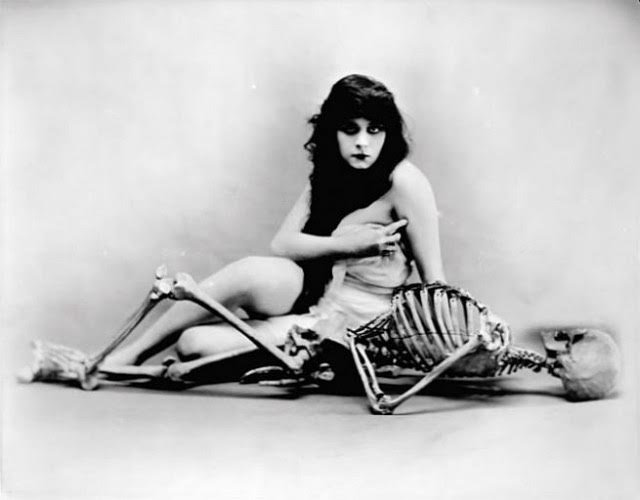Readers of a certain generation, asked to envision a vampirically alluring lady of cinema, may find their imaginations going straight to Elvira, Mistress of the Dark. But the tradition of the silver-screen “vamp” goes much deeper, reaching all the way back to the silent era. The term itself was first coined to refer to Theda Bara, not exactly a household name now, but then in a league with Charlie Chaplin and Mary Pickford. She was one of the most popular performers alive.

Bara revealed to a generation of moviegoers the sheer erotic power of cinema, an accomplishment you can glimpse in the clip above of 1915’s A Fool There Was, the picture that made her an icon. The minute she arrives on screen, writes The Guardian’s Kira Cochrane, “it becomes obvious why she was so popular — why she went on to have songs written about her, children named after her, a perfume and even a sandwich (minced ham, mayonnaise, sliced pimento and sweet pickles on toast — served warm) created in her honour.” Her face, though it may not seem so notable at first, soon “comes into its own — so much so that when you learn that her character’s malevolence has led one man to jail, another to beggary, and her most recent victim to a very public suicide, you believe it.”

Frank Powell, director of A Fool There Was, “took a chance on a 29 year-old Theda (she lied and said she was 25)” by asking her to star, writes Messy Nessy’s Addison Nugent. “It’s the story of a devoted family man who, while on a ship to England, meets a beautiful stranger referred to only as ‘The Vampire Woman.’ This mysterious creature corrupts his soul, destroys his family, drains him of all of his money and dignity, and eventually causes his demise.”
And so the former Theodosia Goodman — with some assistance from Fox Studios’ PR team, who “planted false stories in the press and invented a fantasy backstory for her” — swiftly became a new kind of femme fatale for this new artistic and commercial medium. These dangerous young women, write the New York history podcasters the Bowery Boys, “were the spiritual children of the prior generation of newly empowered women who fought against the constraints of Victorian society. A few years later, as another vein of female power (the temperance movement) helped bring about Prohibition, these young women would be called flappers, carefree and fueled on the powers of jazz and illegal alcohol.”
During her dozen-year-long screen career, Bara made some forty films in total, most of them lost in the Fox vault fire of 1937, including the 1917 epic Cleopatra, a few fragments of which you can see in the video above. Her final appearance, in 1926’s Madame Mystery, both parodied the vamp image she could never quite shake and saw her bid farewell to the world of silent cinema. “Before pictures grew up and started to talk, we had to translate all our motion into pantomime,” said Bara herself in a later radio interview. “We had to express jealousy, hate, love, or devotion all in pantomime, and at the same time keep pace as the director guided us just as a metronome guides a pianist.”

The vamp, as Bara played and defined the figure, expressed all those emotions with a fearsome vividness, and she “became so synonymous with the term that she is now referred to as the original on-screen vamp,” writes Cochrane, “the woman who made performances such as that of Louise Brooks in Pandora’s Box, Barbara Stanwyck in Double Indemnity and Linda Fiorentino in The Last Seduction possible.” Or as the original vamp summed up her own legacy, “To be good is to be forgotten. I’m going to be so bad I’ll always be remembered.”
A Fool There Was will be added to our collection, 4,000+ Free Movies Online: Great Classics, Indies, Noir, Westerns, Documentaries & More.
Related Content:
Watch After the Ball, the 1897 “Adult” Film by Pioneering Director Georges Méliès (Almost NSFW)
Brokeback Before Brokeback: The First Same-Sex Kiss in Cinema (1927)
Based in Seoul, Colin Marshall writes and broadcasts on cities and culture. He’s at work on a book about Los Angeles, A Los Angeles Primer, the video series The City in Cinema, the crowdfunded journalism project Where Is the City of the Future?, and the Los Angeles Review of Books’ Korea Blog. Follow him on Twitter at @colinmarshall or on Facebook.


Leave a Reply